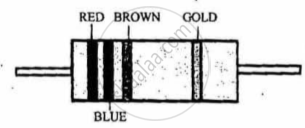Advertisements
Advertisements
Question
A metallic wire has a resistance of 3.0 Ω at 0°C and 4.8 Ω at 150°C. Find the temperature coefficient of resistance of its material.
Solution
Here, R0 = 30 Ω , Rt = 4.8 Ω , t = 150° C , α = ?, where α is the temperature coefficient of resistance.
We know that
Rt = R (1 + αt)
α = `("R"_"t" - "R"_0)/("R"_0 xx "t")`
`= (4.8 - 3.0)/(3xx150)`
`= 1.8/(3xx150)`
= 4 × 10-3° C-1
APPEARS IN
RELATED QUESTIONS
At room temperature (27.0°C) the resistance of a heating element is 100 Ω. What is the temperature of the element if the resistance is found to be 117 Ω, given that the temperature coefficient of the material of the resistor is 1.70 × 10−4 °C−1.
Draw labelled graphs to show how electrical resistance varies with temperature for:
1) a metallic wire.
2) a piece of carbon
The thermal energy developed in a current-carrying resistor is given by U = i2 Rt and also by U = Vit. Should we say that U is proportional to i2 or i?
Consider a circuit containing an ideal battery connected to a resistor. Do "work done by the battery" and "the thermal energy developed" represent two names of the same physical quantity?
A non-ideal battery is connected to a resistor. Is work done by the battery equal to the thermal energy developed in the resistor? Will your answer change if the battery is ideal?
When a current passes through a resistor, its temperature increases. Is it an adiabatic process?
Is inversion temperature always double the neutral temperature? Does the unit of temperature have an effect in deciding this question?
Is neutral temperature always the arithmetic mean of the inversion temperature and the temperature of the cold junction? Does the unit of temperature have an effect in deciding this question?
A carbon resistor has coloured bands as shown in Figure 2 below. The resistance of the resistor is:

figure 2
The specific resistance of all the metals is the most affected by ______
